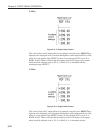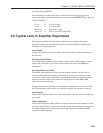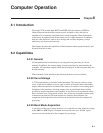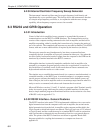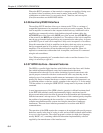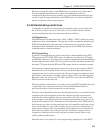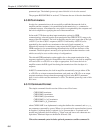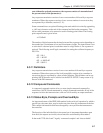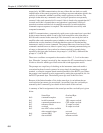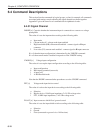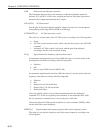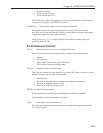
6-6
Chapter 6, COMPUTER OPERATION
parameter byte. The default (power-up) state of this bit is for it to be asserted.
The program RSCOM2.BAS in section C.2 illustrates the use of the echo handshake.
6.3.09 Terminators
In order for communications to be successfully established between the lock-in
amplifier and the computer, it is essential that each transmission, i.e. command or
command response, is terminated in a way which is recognizable by the computer and
the lock-in amplifier as signifying the end of that transmission.
In the model 7220 there are three input termination options for GPIB
communications, selected from the front panel under the GPIB SETUP 1 menu or by
means of the GP command. The lock-in amplifier may be set to expect the <CR> byte
(ASCII 13) or the <CR,LF> sequence (ASCII 13 followed by ASCII 10) to be
appended by the controller as a terminator to the end of each command, or
alternatively instead of a terminator it may expect the EOI signal line (pin 5 on the
GPIB connector) to be asserted during the transmission of the last character of the
command. The third option is normally to be preferred with modern interface cards
which can easily be set to a wide variety of configurations.
The selected GPIB termination option applies also to the output termination of any
responses sent back by the lock-in amplifier to the controller, i.e. the lock-in amplifier
will send <CR> or <CR,LF> or no byte as appropriate. In all cases the lock-in
amplifier asserts the EOI signal line during the transmission of the last byte of a
response.
In RS232 communications, the lock-in amplifier automatically accepts either <CR>
or <CR,LF> as an input command terminator, and sends out <CR,LF> as an output
response terminator except when the noprompt bit (bit 4 in the RS232 parameter
byte) is set in which case the terminator is <CR>. The default (power-up) state of this
bit is zero.
6.3.10 Command Format
The simple commands listed in section 6.4 have one of five forms:
CMDNAME terminator
CMDNAME n terminator
CMDNAME [n] terminator
CMDNAME [n
1
[n
2
]] terminator
CMDNAME n
1
[n
2
] terminator
where CMDNAME is an alphanumeric string that defines the command, and n, n
1
, n
2
are parameters separated by spaces. When n is not enclosed in square brackets it must
be supplied. [n] means that n is optional. [n
1
[n
2
]] means that n
1
is optional and if
present may optionally be followed by n
2
. Upper-case and lower-case characters are
equivalent. Terminator bytes are defined in section 6.3.09.
Where the command syntax includes optional parameters and the command is



